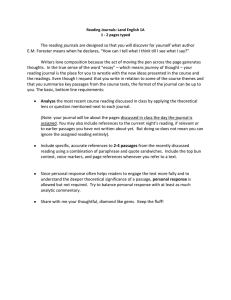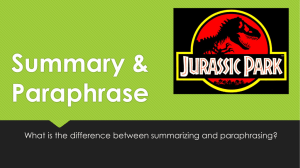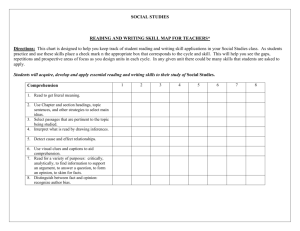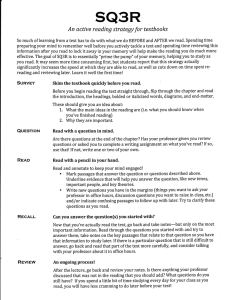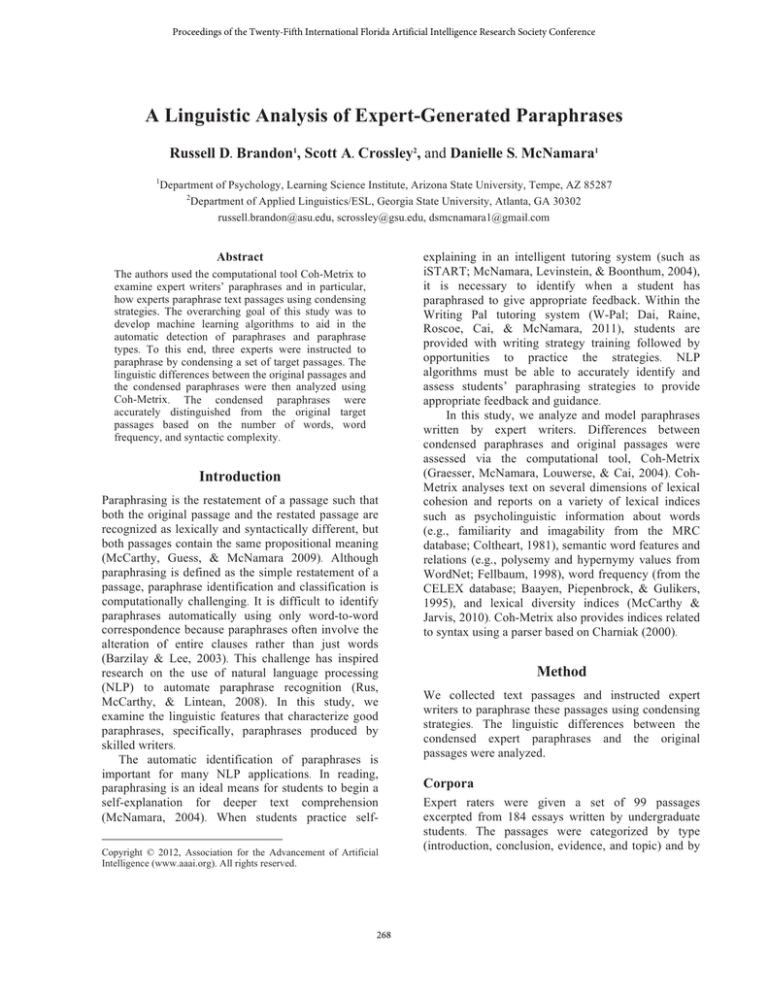
Proceedings of the Twenty-Fifth International Florida Artificial Intelligence Research Society Conference
A Linguistic Analysis of Expert-Generated Paraphrases
Russell D. Brandon1, Scott A. Crossley2, and Danielle S. McNamara1
1
Department of Psychology, Learning Science Institute, Arizona State University, Tempe, AZ 85287
2
Department of Applied Linguistics/ESL, Georgia State University, Atlanta, GA 30302
russell.brandon@asu.edu, scrossley@gsu.edu, dsmcnamara1@gmail.com
Abstract
The authors used the computational tool Coh-Metrix to
examine expert writers’ paraphrases and in particular,
how experts paraphrase text passages using condensing
strategies. The overarching goal of this study was to
develop machine learning algorithms to aid in the
automatic detection of paraphrases and paraphrase
types. To this end, three experts were instructed to
paraphrase by condensing a set of target passages. The
linguistic differences between the original passages and
the condensed paraphrases were then analyzed using
Coh-Metrix. The condensed paraphrases were
accurately distinguished from the original target
passages based on the number of words, word
frequency, and syntactic complexity.
Introduction
Paraphrasing is the restatement of a passage such that
both the original passage and the restated passage are
recognized as lexically and syntactically different, but
both passages contain the same propositional meaning
(McCarthy, Guess, & McNamara 2009). Although
paraphrasing is defined as the simple restatement of a
passage, paraphrase identification and classification is
computationally challenging. It is difficult to identify
paraphrases automatically using only word-to-word
correspondence because paraphrases often involve the
alteration of entire clauses rather than just words
(Barzilay & Lee, 2003). This challenge has inspired
research on the use of natural language processing
(NLP) to automate paraphrase recognition (Rus,
McCarthy, & Lintean, 2008). In this study, we
examine the linguistic features that characterize good
paraphrases, specifically, paraphrases produced by
skilled writers.
The automatic identification of paraphrases is
important for many NLP applications. In reading,
paraphrasing is an ideal means for students to begin a
self-explanation for deeper text comprehension
(McNamara, 2004). When students practice selfCopyright © 2012, Association for the Advancement of Artificial
Intelligence (www.aaai.org). All rights reserved.
268
explaining in an intelligent tutoring system (such as
iSTART; McNamara, Levinstein, & Boonthum, 2004),
it is necessary to identify when a student has
paraphrased to give appropriate feedback. Within the
Writing Pal tutoring system (W-Pal; Dai, Raine,
Roscoe, Cai, & McNamara, 2011), students are
provided with writing strategy training followed by
opportunities to practice the strategies. NLP
algorithms must be able to accurately identify and
assess students’ paraphrasing strategies to provide
appropriate feedback and guidance.
In this study, we analyze and model paraphrases
written by expert writers. Differences between
condensed paraphrases and original passages were
assessed via the computational tool, Coh-Metrix
(Graesser, McNamara, Louwerse, & Cai, 2004). CohMetrix analyses text on several dimensions of lexical
cohesion and reports on a variety of lexical indices
such as psycholinguistic information about words
(e.g., familiarity and imagability from the MRC
database; Coltheart, 1981), semantic word features and
relations (e.g., polysemy and hypernymy values from
WordNet; Fellbaum, 1998), word frequency (from the
CELEX database; Baayen, Piepenbrock, & Gulikers,
1995), and lexical diversity indices (McCarthy &
Jarvis, 2010). Coh-Metrix also provides indices related
to syntax using a parser based on Charniak (2000).
Method
We collected text passages and instructed expert
writers to paraphrase these passages using condensing
strategies. The linguistic differences between the
condensed expert paraphrases and the original
passages were analyzed.
Corpora
Expert raters were given a set of 99 passages
excerpted from 184 essays written by undergraduate
students. The passages were categorized by type
(introduction, conclusion, evidence, and topic) and by
essay quality (low or high). The experts were given the
following instructions for paraphrasing:
Please provide a condensed paraphrase for the
original passage above. Condensed paraphrasing
means restating an idea that you have read using
fewer words or sentences. When you paraphrase
and condense you must make sure that it all still
makes sense to your reader. However, you don't
always have to change the words and structure. If
you know a better way or different way to say
something, then it's fine to use that way.
The final corpus contained 99 original passages
and 297 condensed paraphrases (i.e., 100 paraphrases
from each expert). We used Coh-Metrix to compute
linguistic features for the passages and paraphrases.
We then examined which linguistic features showed
differences between the passages and the paraphrases
using an ANOVA. A discriminant function analysis
(DFA) was used to classify the passages and
paraphrases.
Coh-Metrix Analysis
For this analysis, we selected Coh-Metrix indices
related to cohesion, lexical sophistication, and
syntactic complexity. These indices were selected
because they have theoretical overlap with common
paraphrasing strategies (i.e., changing the structure and
vocabulary found in a sample).
Number of words. Coh-Metrix calculates the number
of words in a text and other basic properties.
Word frequency. Word frequency indices measure
how often words occur in the English language
(CELEX).
Word polysemy. Polysemy measures the number of
senses a word has (WordNet).
Word hypernymy. Hypernymy assesses the
specificity of words in a text (WordNet).
Word concreteness. Words that refer to an object,
material, or person generally receive a higher
concreteness score than abstract words (MRC
Psycholinguistic Database).
Word familiarity. Familiarity measures how likely
words are to appear in spoken discourse (MRC
Psycholinguistic Database).
Word imageability. Indicates whether words easily
evoke imagery (MRC Psycholinguistic Database).
Word meaningfulness. Measures the strength of
association a word has to other words (MRC
Psycholinguistic Database).
Connectives and Logical Operators. Coh-Metrix
reports connectives for two dimensions: positive
versus negative connectives and additive, temporal,
and causal connectives. The logical operators include
variants of or, and, not, and if-then combinations.
Causality. Coh-Metrix calculates causality through the
ratio of causal verbs to causal particles. The causal
verb count is based on the number of main causal
verbs (WordNet).
Syntactic complexity. Coh-Metrix measures the mean
number of modifiers per noun phrase or the mean
number of high-level constituents per word and per
noun phrase.
Statistical Analysis
An ANOVA was conducted to select variables that
best distinguished original passages and condensed
paraphrases. A DFA was then used to predict group
membership (the original passages or the condensed
paraphrases) using a series of independent variables
(the linguistic indices selected from the ANOVA). We
used the DFA first on the entire set. A leave-one-out
cross-validation model was then used in which one
instance in turn is left out with 395 remaining
instances as the training set. We report the findings of
the DFA using an estimation of the accuracy of the
Table 1
ANOVA results for selected linguistic indices: Means, standard deviations, f value, p value, and hp2
Original
Condensed
f value
p value
hp2
41.980 (28.317)
16.686 (11.654)
449.865
< .001
0.605
CELEX word frequency in sentence
2.796 (0.238)
2.472 (0.373)
230.891
< .001
0.440
Word hypernymy
1.738 (0.537)
2.086 (0.661)
83.685
< .001
0.222
52.245 (44.244)
78.814 (73.317)
57.147
< .001
0.163
Number of words
Number of causal verbs and particles
Word familiarity every word
592.703 (8.799)
587.686 (13.396)
46.349
< .001
0.136
Word imagability every word
325.334 (23.764)
338.464 (36.407)
46.403
< .001
0.136
Number of words before main verb
5.387 (4.669)
3.524 (3.081)
39.222
< .001
0.118
Word polysemy
4.239 (1.259)
3.919 (1.529)
9.267
< .010
0.031
94.381 (46.623)
80.964 (68.770)
9.492
< .010
0.031
Incidence of all connectives
269
analysis by plotting the correspondence between the
actual texts and the predictions made by the DFA
model. Results are in terms of recall, precision, and F1
score. Precision scores are computed by tallying the
number of hits over the number of hits + misses.
Recall is the number of correct predictions divided by
the sum of the number of correct predictions and false
positives. The F1 score is a weighted average of the
precision and recall results.
Analysis and Results
ANOVA
Repeated measures ANOVAs were conducted using
the selected Coh-Metrix indices as the independent
variables and the original passages and condensed
paraphrases as the dependent variables. Descriptive
statistics for the selected Coh-Metrix indices are
presented in Table 1. The indices from each measure
with the greatest effect size were selected for the DFA.
Collinearity
Two of the 11 variables demonstrated multicollinearity
(r > .70). These variables were concreteness scores
every word and meaningfulness scores every word,
both correlated highly with word imagability every
word. Because word imagability every word
demonstrated a greater effect size with our dependent
variables, it was retained while the other indices were
removed from the analysis. The tolerance checks of
VIF values and tolerance levels for remaining indices
were approximately 1, indicating that the model data
did not suffer from multicollinearity. Descriptive
statistics for the final variables are located in Table 1.
DFA
The Wilks’s Lambda for the discriminant function was
significant, Λ = .66, χ2 = 161.825, p < .001. The results
demonstrate that the DFA correctly classified 320 of
the 396 texts in the total set (df =1, n=39, χ2= 98.502, p
< .001) for an accuracy of 88.8%. For the crossvalidated set, the DFA correctly allocated 316 of the
396 samples for an accuracy of 79.8% (see Table 2).
The measure of agreement between the actual text type
and the model produced a Cohen’s Kappa of 0.498.
The precision and recall scores for predicting sample
type are presented in Table 2. The accuracy for the
total set was .749 and the cross-validated set was .738.
The discriminant function coefficients (DFC) from
the discriminant analysis correspond to the partial
contributions in the discriminant function. The indices
that most strongly contributed to classifying the texts
as either original passages or condensed paraphrases
were the number of words, word frequency, and the
mean number of words before the main verb. The
270
standardized discriminant function coefficients are
reported in Table 3.
DFA without Text Length Index
We conducted a post-hoc analysis to examine the
predictive strength of the Coh-Metrix indices in the
absence of the text length index to assess how well
purely linguistic indices distinguished original
passages from condensed passages. We used the same
corpus of passages and paraphrases as our dependent
variables and used all indices reported by Coh-Metrix
except the text length index as independent variables.
Table 2
Classification results for among grade level analyses
Original
Total set
Percentage
CrossValidated
Percentage
Condensed
Original
64
35
Condensed
41
256
Original
64.60
35.40
Condensed
13.80
86.20
Original
63
36
Condensed
44
253
Original
63.60
36.40
Condensed
14.80
85.20
Table 3
Standardized Discriminant Function Coefficients
Index
Coefficient
Number of words
CELEX word frequency
Syntactic complexity
Word polysemy
Word imagability
Causal verbs and particles incidence
Word familiarity
Connectives incidence
0.802
0.315
0.202
0.181
0.052
0.017
0.015
-0.028
Word hypernymy
-0.130
The Wilks’s Lambda for the discriminant function
was significant, Λ = .815, χ2 = 79.822, p < .001. The
results demonstrate that the DFA correctly classified
274 of the 396 texts in the total set (df =1, n=395, χ2=
50.535, p < .001) for an accuracy of 69.2%. For the
cross-validated set, the DFA correctly allocated 271 of
the 396 samples for an accuracy of 68.4%. The
strongest classifiers were word frequency and
syntactic complexity (with discriminant function
coefficients of .736 and .449 respectively).
Discussion and Conclusion
The goal of this study was to develop machine
learning algorithms to aid in the automatic detection of
paraphrases and paraphrase types. The results
indicated that original passages and condensed
paraphrases can be discriminated using linguistic
features related to text length, word sophistication and
syntactic complexity.
Number of words made the largest contribution in
the DFA. Word frequency and syntactic complexity in
the absence of a number of words indices remained
strong predictors of whether a passage was original or
condensed. These two indices classified 69% of the
paraphrases and passages correctly.
Content word frequency demonstrated that the
process of paraphrasing involves the production of
more infrequent words. The use of more infrequent
words is likely related to the removal of frequent
words when condensing and the condensing of longer
phrases into more concise phrases using rarer words.
Syntactic complexity was also an important
contributor in the DFA with original passages
containing greater syntactic complexity than
condensed paraphrases. This is likely because number
of words before the main verb was reduced, shortening
the length of the sentence.
The ANOVA and DFA results demonstrated that
many lexical indices and indices of cohesion were
indicators of condensing paraphrases. The lexical
indices demonstrated that experts used more specific
words that were more imagable and less ambiguous
but also less familiar. Expert paraphrasers also used
fewer connectives and greater causality. Experts
condense by using more distinct words that are less
familiar and by reducing connected phrases. However,
cohesion is increased through the use of more causal
verbs and particles.
These analyses show that differences exist at
the lexical and syntactic level as well as with text
length. These results have multiple applications. These
features may be used to identify paraphrases with
automated algorithms. They may also inform
processes in which experts engage when they
paraphrase (Petrić & Czárl, 2003). The algorithm
developed can also be extended to intelligent tutoring
systems to assess when a passage has been
paraphrased using condensing strategies.
To further this research, future studies might focus
on other types of paraphrases (paraphrasing when
words and structure are changed, but the passage is not
condensed) and on other indicators of paraphrases
(e.g., topic continuity and rhetorical features). The
application of the current findings should also be
tested in pedagogical settings. Finally, while the
results of this study indicate that assessing the type of
271
paraphrase produced using machine learning
algorithms is successful, the success of such
algorithms in assessing the quality of a paraphrase is
as yet untested.
Acknowledgments
This research was supported in part by the Institute for
Education Sciences (R305A080589, R305602001802). We thank Vasile Rus, Art Graesser, and Zhiqiang
Cai for their assistance in this research. We also thank
Brad Campbell, Meg Henderson, and Tyler Trimm for
providing the paraphrases used in this analysis.
References
Baayen, R. H., Piepenbrock, R., & Gulikers, L. 1995.
CELEX. Philadelphia, PA: Linguistic Data Consortium.
Barzilay, R., & Lee, L. 2003. Learning to paraphrase : an
unsupervised
Approach
Using
Multiple-Sequence
Alignment. Proceedings of HLT-NAACL. 16-23. Edmonton,
Canada.
Charniak, E. 2000. A maximum-entropy-inspired parser. The
Proceedings of the North American Chapter of the
Association for Computational Linguistics : 132–139.
Coltheart, M. 1981. The MRC psycholinguistic database.
Quarterly Journal of Experimental Psychology 33: 497-505.
Dai, J., Raine, R. B., Roscoe, R., Cai, Z., & McNamara, D.
S. 2011. The Writing-Pal tutoring system : Development and
design. Computer, 2 1-11.
Fellbaum, C. 1998. WordNet: An electronic lexical
database. Cambridge, MA: MIT Press.
Graesser, A. C., McNamara, D. S., Louwerse, M. & Cai, Z.
2004. Coh-metrix: analysis of text on cohesion and
language. Behavior Research Methods, Instruments, &
Computers 36:193-202.
McCarthy, P. M., Guess, R. H., & McNamara, D. S. 2009.
The components of paraphrase evaluations. Behavior
Research Methods. 41:682-690.
McCarthy, P. M., Jarvis, S. 2010. MTLD, vocd-D, and HDD: A validation study of sophisticated approaches to lexical
diversity assessment. Behavior Research Methods. 42.
McNamara, D. S. 2004. SERT: Self-explanation reading
training. Discourse Processes, 38:1-30.
McNamara, D. S., Levinstein, I. B., & Boonthum, C. 2004.
iSTART: Interactive strategy training for active reading and
thinking. Behavior Research Methods, Instruments, &
Computers 36: 222-233.
Petrić, B., & Czárl, B. 2003. Validating a writing strategy
questionnaire. System 31:187-215.
Rus, V., McCarthy, P. M., Lintean, M. C., McNamara, D. S.,
& Graesser, A. C. 2008. Paraphrase identification with
Lexico-Syntactic graph subsumption. Artificial Intelligence,
201-206.
Wilson, M. D. 1988. The MRC psycholinguistic database:
Machine readable dictionary, version 2. Behavioural
Research Methods, Instruments, and Computers, 20: 6–11.

